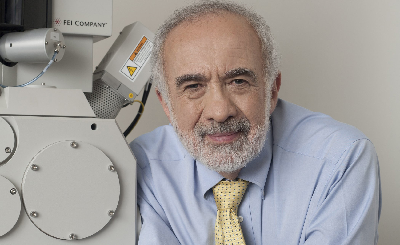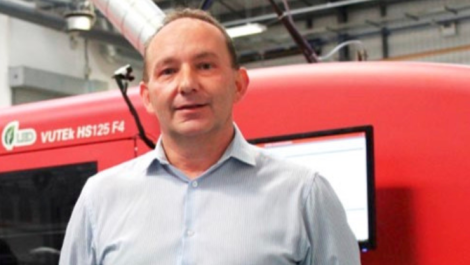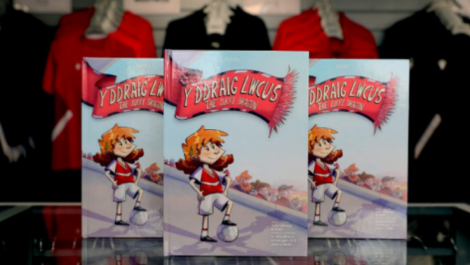The brand new Nanographic digital printing process developed by Landa Corporation is being demonstrated in presses of a striking new design at drupa. It’s potentially the most exciting announcement we’re likely to see at the show.
At a press conference yesterday the company’s founder Benny Landa revealed the company’s first presses. The process has been under development for eight years, he revealed, funded in part by the payment he received after selling his original Indigo digital press company to HP in 2002.
Target markets for the Nanographic presses are ‘mainstream’ commercial print and packaging work. According to Mr Landa, today’s digital printing procsses only have a 2% market penetration worldwide. ‘We’re going after the other 98%,’ he said, though he qualified this as still meaning relatively short run printing.
Although Mr Landa is claiming that Nanography will have the lowest cost per copy of any digital process, partly because standard papers and plastics can be printed, he admits that offset will still cost less for long runs.
The run up to the show also saw licensing agreements for the Landa technology announced by the offset press makers Heidelberg and manroland sheetfed. Two weks ago Komori announced a similar licensing agreement and revealed that it was providing the media transport hardware for Landa’s own presses.
Landa itself is announcing three sheet fed and three web presses. Sheet fed models are the B3 format S5 (for 11,000 sheets per hour simplex, 5500 simplex), B2 (8800 to 12,000 sph simplex, 4400 to 6000 duplex S7 and B1 S7 (6500 to 13,000 simplex, 3,250 to 6500 duplex. The S7 will be available in configurations for either commercial print or folding packaging. Commercial models take paper from 60 to 350 g/m2.
The web presses are the 560 mm web W5 for 100 to 200 metres per minute simplex, the 1020 mm web W10 running at the same speed, and the 560 mm W50 for up to 200 metres per minute duplex. First shipments are expected at the end of 2013 or possibly into 2014.
Several of the presses are being demonstrated at drupa, starting today. They are printing sample work, although though company founder Benny Landa pointed out that they are not yet perfected and there is some way to go on image quality and other bugs. This is why production machines won’t ship for another 18 months or so, he said.
The presses will be able to print up to eight colours, including special security inks. Resolution can be 600 x 600 or 1200 x 600 dpi with ‘multiple grey levels.’
Externally the presses are relatively short, but wide, so they have a more or less square footprint. The web models have external reel unwinders and rewinders, while the sheet fed models have integral pile feeders and deliveries.
What is most striking about the exterior is that the whole of the operator’s side looks like a huge touch panel, with interactive displays of the machine status, job lists, current job previews, and contextual touch controls. This is an entirely new way of controlling a press. Magnets are used to attach pull sheets from the press next to visual displays of the job images.
The Landa Nanography process has still not yet been fully explained. What has been revealed is that it is a modified inkjet process that uses NanoInk, a water based ink containing ultra fine particles, said to be ‘tens of nanometres’ across. Ths is initally printed onto a heated blanket belt and then transferred to the substrate. The result is said to promote almost instant drying.
As a result, no special coating is needed for the paper, which can be virtually any type, from uncoated to gloss, as well as plastics for packaging. Sheets emerge dry from the press so duplex printing and immediate finishing can be performed. Landa claims that the ink bonds well to the substate and is highly abrasion resistent.
Once the ink hits the substrate the pigment particles flow and merge slightly to form a film some 500 nanometres thick, the thinnest of any print process according to Mr Landa. This means the print areas match the gloss level of the substrate exactly. The halftone dot edges are extremely sharp too, Mr Landa said, producing enlarged views of offset and ‘conventional’ inkjets as comparisons.
The small ink pigment particles are strong absorbers of light too, according to Mr Landa. In consequence, the colour gamut is very wide, again superior to offset, he said.
Mr Landa remained vague about the print heads, but hinted that they are a modified system from a third party developer. Other suppliers have indicated that they are Kyocera KJ4 piezo heads. Mr Landa calls the heads ‘ejectors,’ rather than inkjet heads. He said that in future both piezo and thermal head systems could be adapted to run NanoInk.
At drupa there are several presses being shown on the company’s large stand in Hall 9. There is also a large theatre area containing one web and one sheet fed press, where Mr Landa is making several presentations every day. This echoes his time at Indigo, when theatre presentations marked most major trade shows following the original launch at Ipex 1993.
Contact: www.landanano.com



